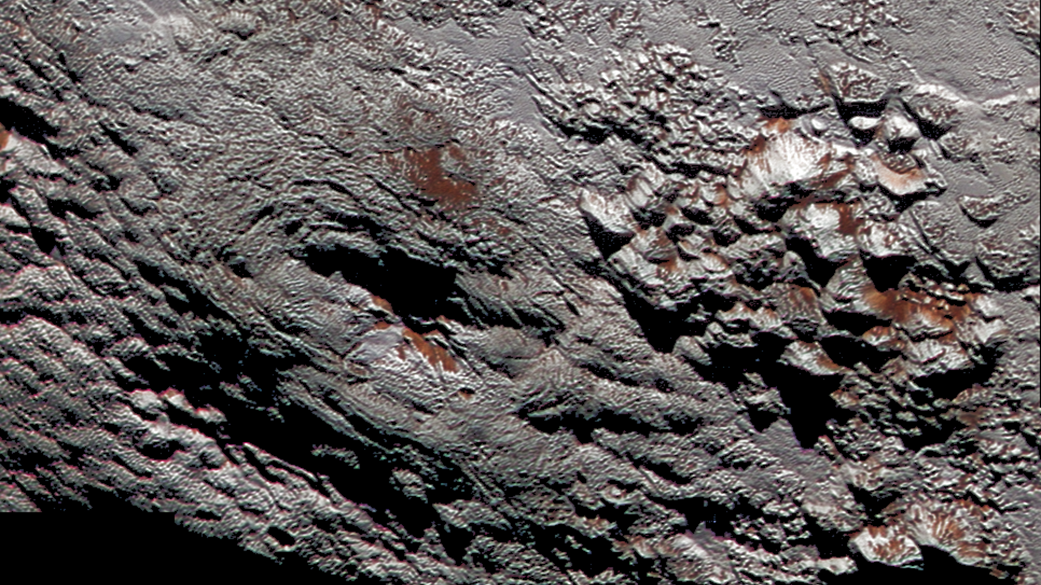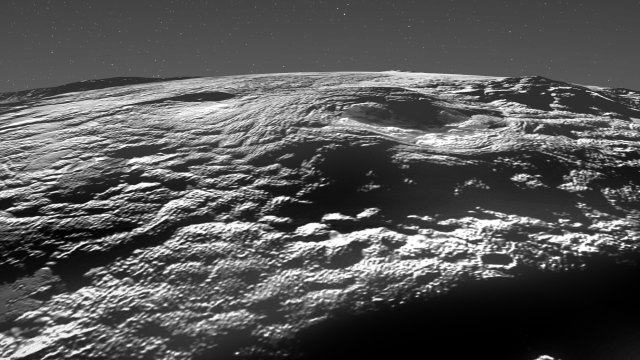Images gathered by NASA’s New Horizons spacecraft in 2015 hinted at the presence of ice volcanoes on Pluto. A new analysis of the data suggests they’re actually a prominent feature of the dwarf planet, with the largest reaching over 6 km high.
Ice volcanoes are similar to “normal” volcanoes except that they spew out icy materials instead of lava. They’re known to exist across the solar system, including on Saturn’s moon Enceladus and the dwarf planet Ceres, with data from New Horizons suggesting they’re even on far-off Pluto. New research published today in Nature Communications claims that ice volcanoes very much exist on the dwarf planet, and to a degree never thought possible.
“We had suspected some features on Pluto were icy volcanos, but now we have determined that there are many of them and that they cover a very large region,” Kelsi Singer, the first author of the new study and a planetary scientist at the Southwest Research Institute in Boulder, Colorado, explained in an email. “That requires a large volume of mobile icy material, and that requires more heat than we originally thought would be available near the surface of Pluto.”
The old saying is that, where there’s smoke there’s fire, but in this case, where there’s cryovolcanoes there must be liquid water. And for liquid water to exist, there must be warmth. Preliminary research suggested there’s hardly any heat beneath Pluto’s surface, but the new findings now challenge this assumption. Singer and her colleagues aren’t entirely sure how Pluto has managed to hold on to so much heat, “but one idea is that there is an insulating layer in Pluto or some parts of Pluto that can trap some heat in, and the heat can build up to higher levels over time,” Singer said.

The largest of the observed features is called Wright Mons, and it rivals Hawaii’s Mauna Loa in size. Geoffrey Collins, a professor of geology at the Physics and Astronomy Department of Wheaton College, likes the new paper but said he’s not ready to declare it a cryovolcano just yet.
“I’ve seen a lot of bizarre things on the surfaces of other worlds, but Wright Mons on Pluto is definitely one of the weirdest,” Collins told me in an email. “This study interprets it to be a volcano, but perhaps we need to throw out some of our Earth-based notions of what volcanoes look like when we’re talking about ice volcanoes on Pluto.”
For the new study, Singer’s team scoured through all of the available data gathered by the New Horizons spacecraft, which zipped past Pluto on July 14, 2015 at speeds reaching 83,686 km per hour (84,000 km/hr). The team “wanted to collect as much information about these structures as possible, including their sizes and shapes, and also what they are made of, to try to understand how they formed,” said Singer.
The scientists focused on an area to the southwest of Sputnik Planitia, a 1,050-km ice-covered impact basin. It’s here where Wright Mons can be found, along with another prominent mound known as Piccard Mons, the former being named after Orville and Wilbur Wright and the latter after Auguste Piccard, a 20th-century physicist and balloonist. These and other features in this area were produced by cryovolcanism, and they consist primarily of water ice, according to the research.
These mounds are impressively huge, especially when considering that Pluto itself measures just 2,380 km wide. The tallest of the volcanic domes measures 7 kilometres high, and they range in size from between 30 to 100 km across. As the paper points out, this terrain is likely the result of multiple eruption sites and significant amounts of eruptive material.
Singer said she was surprised by how large of an area the cryovolcanic material covered, an expanse measuring 300 km by 600 km, at least as far as they could tell. More cryovolcanic material may exist in areas not seen by New Horizons when it zoomed past. She was also surprised by the complexity of the features.
“There were likely many eruption sites and some of the growing volcanic domes merged together,” she said. “It was a challenge to try to figure out how these structures formed, because they look so different from any other structures we have seen anywhere in the solar system. But it was also a fun and interesting puzzle to start with the basic information about the features and try to imagine and figure out how they formed.”
The team experimented with models of various geological processes to see if they could reproduce the icy volcanoes seen on Pluto. “The closest model was one where the material is extruded from below the volcanoes, and they build up a dome by injecting material from below,” Singer explained. “But a lot of the other models we tried didn’t work, and there is still a lot left to explain.”
Interestingly, impact craters are nowhere to be found in this area, in stark contrast to other places on Pluto. This suggests the cryovolcanic activity must’ve happened relatively recently and that Pluto’s internal structure retains significant amounts of residual heat.
Collins said Wright Mons vaguely looks like a cone with a pit in the middle, but on closer inspection its slopes don’t appear to be composed of flows emanating from vents, as happens on Earth volcanoes.
“Instead, it’s a crazy quilt of smaller domes piled on each other, and those are covered by still more bumps and pits,” he told me. “It’s like looking at a head of cauliflower, though that observation doesn’t give us any insight into what caused it. That pit in the middle is huge, suspiciously reaching right back down to the background elevation of the surrounding terrain. There isn’t any good indication that it collapsed back in, like a volcanic caldera. It’s like the construction of the volcano just avoided the middle bit for some reason.”
Ultimately, Collins said we still don’t really know the nature of these features and whether Wright Mons really is a volcano. “I still don’t know,” he said, “but this paper lays out a lot of good data and it has the best idea so far.”
The coolest thing about Pluto is that it didn’t disappoint. The dwarf planet eluded a close inspection for so long, forcing us to imagine what it might actually look like. New Horizons exposed Pluto as being the weirdo we all hoped it would be, an object of curiosity that will keep scientists busy for some time to come.
